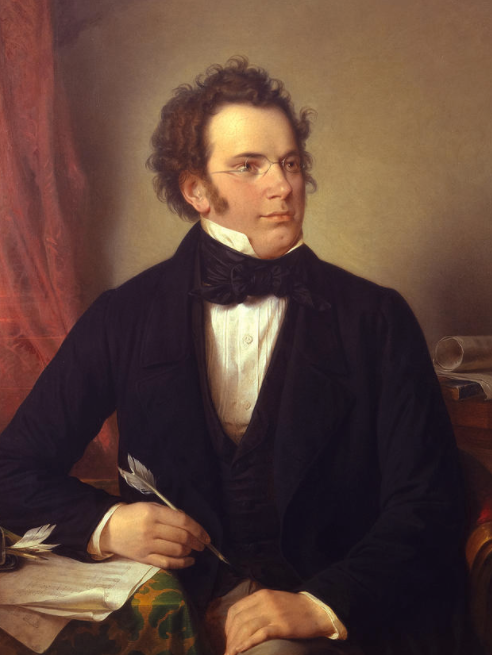Franz Schubert

- Born: January 31, 1797, Vienna, Austria
- Died: November 19, 1828, Vienna, Austria
Octet in F Major, D. 803
- Composed: 2010
- Premiere: March 1824, on commission from clarinetist Ferdinand Troyer
- Duration: approx. 63 minutes
Nineteen-year-old Franz Schubert, in his diary entry for June 16, 1816, declared his independence from Beethoven and decried what he saw as an inappropriate marriage of tragedy with humor: “…the eccentricity that is common among most composers nowadays, and is due almost entirely to one of our greatest German artists—that eccentricity which combines and confuses the tragic and the comic, the agreeable with the repugnant, heroism with howling, and the holiest with mockery, without distinguishing among them.” He concluded, sanctimoniously, that the effect of Beethoven’s music was to “drive people to madness instead of dissolving them in love, provoke them to laughter rather than lifting them up to God.” He reversed that position eight years later, in 1824, when Count Ferdinand Troyer requested a companion piece to Beethoven’s Septet, Op. 20. Schubert obliged with his own Octet, D. 803, emulating not only the tragi-comic character of Beethoven’s work, but also the structure and key relationships.
This about-face is understandable in light of the upheaval in Schubert’s professional and personal life that winter. Many of Schubert’s friends were leaving Vienna for more prestigious opportunities elsewhere. The death of the wife of his patron, Ignaz Sonnleithner, in whose home many of his works had been premiered for a curated list of wealthy dilletantes, had limited the composer’s access to potential patrons. So he threw himself into work on the Octet. As the artist Moritz von Schwind noted at the time, “Schubert has for some time been working on an octet with greatest enthusiasm. If you go to see him during the day, he says, ‘How are you?’ and carries on with writing, at which point you just leave.” Working at lightning speed, Schubert finished the work by March of that year.
Beethoven’s Septet and Schubert’s Octet are both divertimenti, light-hearted 18th-century instrumental works of multiple movements for strings, winds or both. Schubert’s instrumentation follows Beethoven’s model, with violin, viola, cello, double bass, clarinet, horn and bassoon, to which Schubert adds a second violin, thus affording himself the range and color possibilities of the early 18th-century orchestra. Schubert also emulated Beethoven’s six-movement structure, as well as many of its components: the slow introductions of the first and last movements, the juxtaposition of the minuet—already outmoded—with its more fashionable replacement, the scherzo, and the set of variations that stands as the centerpiece of the work.
Schubert integrates the Adagio introduction into the subsequent Allegro by foreshadowing its rhythmic motive, as well as by bringing the opening theme back at its Adagio original speed. This is genius: he doesn’t actually slow the tempo, but rather, he tricks the ear by laying out the music in note values double the original to match the opening. In the tranquil second movement, we see the centrality of the clarinet to the work. This was no coincidence—Troyer, who commissioned it, was himself an excellent clarinetist. The scherzo follows, and then the set of variations. Schubert was unapologetic about incorporating the best tunes from his vocal music into his instrumental works, as he does here, retooling the vocal duet from his unperformed Singspiel, Die Freunde von Salamanka. The fifth movement shows its distinctly Austrian roots in the lilting charm of its trio, a Ländler.
Schubert begins the final movement with a brooding Andante in the parallel minor key before launching into a cheerful Allegro, mixing pathos with wit in direct contradiction to his youthful criticism of Beethoven. He brings the work full circle with the reappearance of the introduction from the first movement before leading the work to a spirited finish.
The premiere of the Octet did not take place until 1827, in a performance at the residence of Archduke Randolph that included many of the players who had premiered Beethoven’s Septet. Criticized for its length, the Octet was almost immediately regarded as a footnote to the spectacularly fashionable Septet, which by then had achieved a status that even Beethoven himself found irritating. As was the case with much of Schubert’s music, the complete score only first appeared in print half a century later, when it assumed a place of pride among the most important works for strings and winds of the 19th century.
—Dr. Scot Bozza